The convective cloud feedback theory explains a way in which heat could be trapped in the high latitudes through the development of high-altitude convective clouds. Dorian Abbot and Eli Tziperman introduced this theory in 2008 and claimed that during equable climates, changes to the climate system only changed the polar climate. Their theory states that carbon dioxide increased enough to melt sea ice in the high latitudes. This decrease in ice allowed more moisture and heat to enter the atmosphere. This change destabilized the atmosphere and initiated atmospheric convection, which caused the creation of optically thick convective clouds and increased the amount of water vapor at high-altitude. The water vapor and the clouds then caused the atmosphere to trap more outgoing longwave radiation and led to more atmospheric warming and sea ice loss (Abbot, Walker, and Tziperman, 2009).
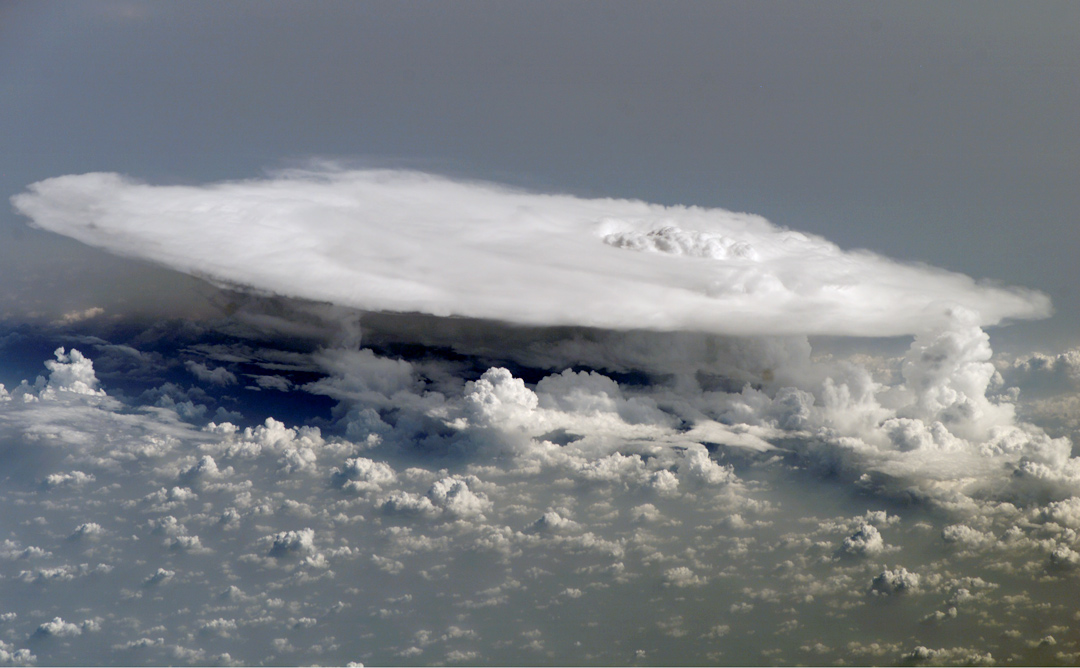
Convective clouds form at high altitudes due to atmospheric convection. (Image courtesy of Expedition Crew 16, Image Science and Analysis Laboratory, Johnson Space Center)
While that quick explanation covers the basics of the theory, more details are necessary to fully comprehend the importance of this feedback. Being a greenhouse gas, carbon dioxide greatly affects atmospheric temperature because it traps OLR attempting to escape the Earth's atmosphere and, thus, helps to heat the atmosphere. While some carbon dioxide is necessary to keep the Earth at a habitable temperature for organisms, increasing its concentration considerably could warm the planet enough to change its characteristics. One of the results of more carbon dioxide is the loss of sea ice due to higher atmospheric temperatures. If the climate is warmer by even a few degrees, sea ice cannot accumulate as rapidly during the winter, and its maximum extent slowly decreases. As a result, more of the ocean surface is in contact with the atmosphere. Then, as this theory states, the two can more easily exchange heat and moisture because there is no longer a layer of ice through which the heat and the water vapor would have to travel. Therefore, less ice means more ocean-atmosphere interactions.
During the winter, the ocean in the high-latitudes is warmer than the atmosphere because water has a higher specific heat than air. Specific heat measures the amount of energy required to change the temperature of a body by a degree. Therefore, since water has a higher specific heat than air does, it takes more energy to change water temperature than to change air temperature. As a result, the ocean stays warmer than the atmosphere during the winter. Consequently, the ocean emits heat into the atmosphere and warms the air directly above the sea surface. Since air temperature and the atmospheric water vapor saturation point are directly correlated, the amount of water vapor able to enter the atmosphere from the ocean increases as the air above the ocean surface warms. Therefore, if the amount of sea ice were to decrease during the winter, the air directly above the sea surface in the high-latitudes would become significantly warmer and moister than if the sea ice were still present.
Warmer and moister air at the sea surface would destabilize the atmospheric column directly above it because the surface air would be more buoyant than the air above it. As a result, atmospheric convection would occur, and the air packet would rise. As the packet would rise, it would slowly cool, and the water vapor within it would condense. Because energy, known as latent heat, is released by water vapor when it condenses into water, the heat emitted would keep the air packet warmer than the surrounding air, and the packet would continue to rise until the latent heat would not warm it enough to be more buoyant than the air around it. Through this process, the rising air packet would force the low-altitude stratus clouds upward to higher altitudes, and they would become convective clouds.
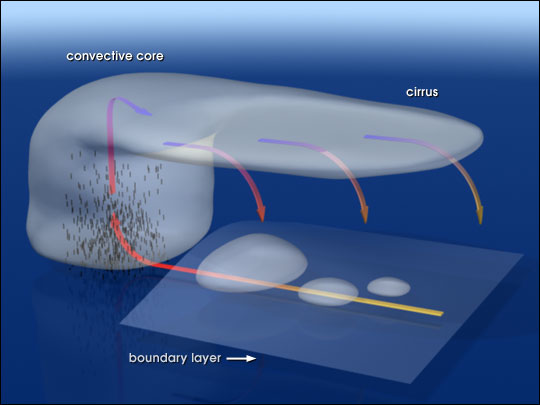
Atmospheric convection occurs when warm air from the surface rises to high altitudes. (Image courtesy of Robert Simmon)
While stratus clouds tend to have a negative cloud radiative forcing (CRF), convective clouds can have a neutral or positive CRF, so their formation is significant. Clouds reflect incoming shortwave radiation (SW), so they reduce the amount of SW absorbed by the Earth. However, they also absorb OLR and emit some of it back towards the Earth. By analyzing the overall impact of clouds on the amount of radiation entering and leaving the atmosphere due to their reflective and absorptive properties, CRF summarizes the difference in the radiation budget between average cloud conditions and cloud-free conditions. Depending on the cloud characteristics, the CRF can be positive or negative, which, respectively, mean that the clouds heat or cool the Earth. Stratus clouds have higher albedos and cool the Earth, while convective clouds absorb more OLR, have a lower albedo, and heat the Earth. These facts show how a transition from stratus to convective clouds would be highly influential on the climate.
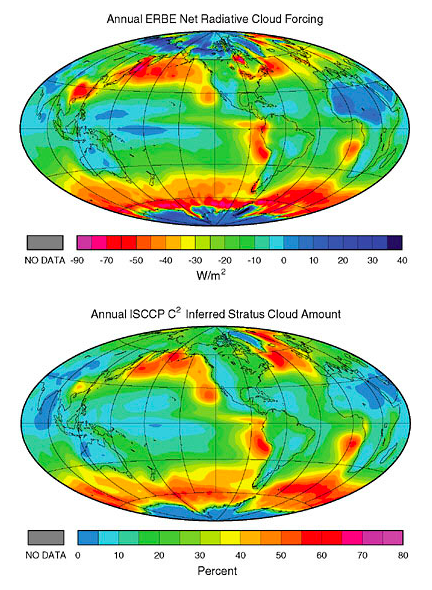
Stratus clouds percentage and CRF are highly correlated due to the reflectivity of stratus clouds. (Image courtesy of D. Hartmann and M. Michelsen, University of Washington)
In addition to convective clouds' ability to heat the Earth, the ability of CRF to reach high positive values is another important aspect of this theory. A CRF of 20 W/m2 due to convective clouds is a perfectly reasonable estimate. In contrast, the CO2 concentration must double to produce a radiative forcing of only 4 W/m2. Therefore, if we assume that the CO2 concentration is 250 ppm, it would have to double 5 times to a concentration of 8000 ppm to produce a radiative forcing of 20 W/m2. This concentration is extraordinarily high, and it seems unlikely that concentrations reached a value of that scale in the Cretaceous and the Eocene. As a result, convective clouds seem to be a much more likely explanation of equable climates because of their ability to dramatically increase the CRF.
An important aspect of the feedback that has not been mentioned yet is that it only occurs during the polar night, so it influences the climate during only the winter half of the year. In the summer, stratus clouds reflect solar radiation and prevent the lower atmosphere from absorbing the radiation (Abbot, Walker, and Tziperman, 2009). As a result, the mid-troposphere warms, while the lower troposphere remains cooler. This arrangement makes the troposphere resistant to convection because the lower troposphere is not warmer than the air above it. Therefore, convective clouds do not form in the summer. This fact is not a problem for explaining equable climates, however, because during the summer, solar radiation warms the high-latitudes. In fact, the polar regions receive the most sunlight in the world during the summer, and they become warm enough to agree with proxy data from equable climates. Because of this fact, the equable climate warming mechanism only needs to warm the high-latitudes during the winter. As a result, the convective cloud feedback appears to be a fitting explanation for the equable climates of the Cretaceous and Eocene.
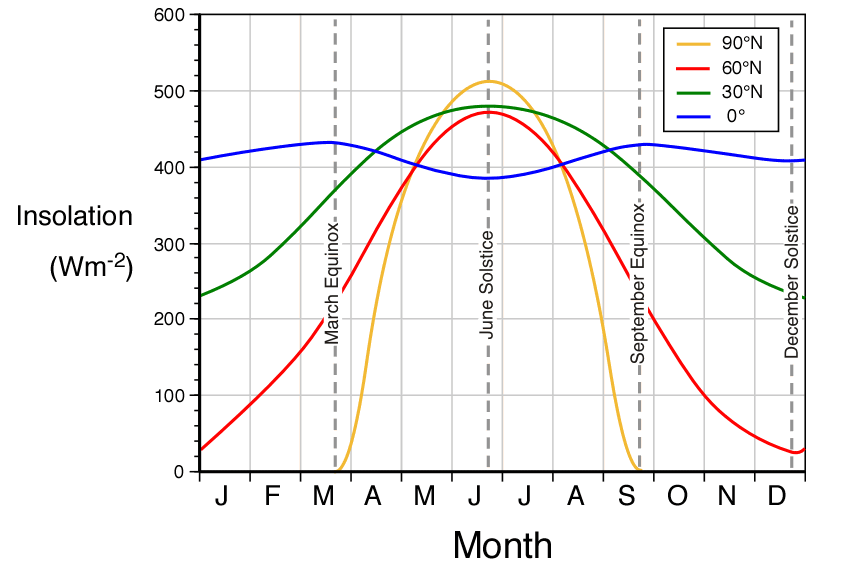
The polar regions receive the most solar radiation during the summer. (Pidwirny, 2006)
To test this idea, Abbot and Tziperman ran a simple model experiment and compared the results from the two stable modes that appeared under different carbon dioxide conditions (Abbot and Tziperman, 2008). MODE1 had convection in only the low-latitudes and was stable at low to intermediate CO2 concentrations, while MODE2 had convection occurring at low and high-latitudes and was stable at intermediate to high CO2 levels. The authors state that the model should only be used for qualitative results, not quantitative ones, but nonetheless, the values produced by their model reveal the importance of the convective cloud feedback. In MODE2, the EPTD was only 12.5°C, while in MODE1, it was 18.7°C. The difference in these values resulted from the changes in SW and OLR. In MODE1, OLR was -247.6 W/m2, and SW was +148.1 W/m2. In MODE2, OLR was -217.6 W/m2, while SW was +159.2 W/m2. Therefore, the difference between SW and OLR in MODE1 was -99.5 W/m2, but it was only -58.4 W/m2 in MODE2. As a result of this discrepancy, the EPTD changed by 6.2°C, and this change demonstrates the substantial impact that high-latitude convection and the production of convective clouds could have on the climate.
Using a more detailed model, Abbot and Tziperman obtained additional results supporting the data from the simple model and shedding more light on the importance of the convective cloud feedback (Abbot and Tziperman, 2008). The detailed model revealed that convection can begin at lower CO2 concentrations than the simple model showed and that the polar regions could warm in only moderately equable climates even without high-latitude convection. Convection could begin in the mid-latitudes, and the atmospheric winds could carry the heat from the mid-latitudes to the polar regions. Through this process, the high-latitudes would warm even at carbon dioxide concentrations at which high-latitude convection would not occur. This fact supports the case for the convective cloud feedback because through just a small increase in carbon dioxide concentrations, the high latitudes could warm preferentially, and the EPTD could decrease.

Information from the detailed model reveals the correlation between temperature (a and b), convective cloud percentage (g), and CRF (i). The Xs represents the case in which convection occurs at high-latitudes, while the Os stand for the case in which convection did not occur at high-latitudes. (Abbot and Tziperman, 2008)
Warming the high latitudes is an essential part of any explanation for equable climates, but another key component is the affect that the mechanism has on sea ice. During the Eocene, sea ice was essentially non-existent (Zachos et al., 1994), so any mechanism that could have caused an equable climate must also eliminate practically all of the sea ice. In addition to warming the high-latitudes, the convective cloud feedback fulfills this requirement as well. Abbot, Walker, and Tziperman (2009) shows that CRF and March sea ice volume are highly correlated. It reveals that in the models used in the IPCC Fourth Assessment Report, as CRF increases, March sea ice volume decreases. Based on this information, since the convective cloud feedback increases CRF, the feedback also theoretically would cause sea ice volume to decrease. The paper asserts that to completely eliminate March sea ice, the convective cloud feedback must be combined with the ocean heat transport feedback, but nonetheless, the convective cloud feedback still is highly influential on sea ice volume. In contrast, March sea ice volume has no correlation to global climate sensitivity, which represents the change in global mean surface temperature at different carbon dioxide levels (Abbot, Walker, and Tziperman, 2009). By not only reducing the EPTD but also decreasing sea ice volume, the convective cloud feedback explains past equable climates in a logical and feasible manner.
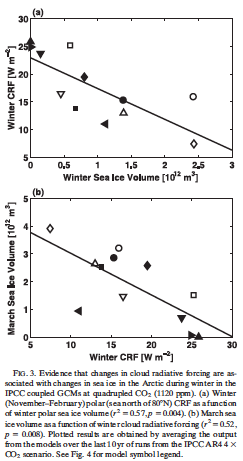
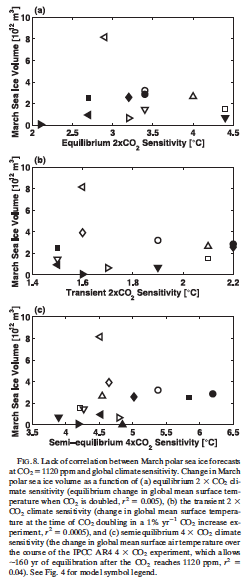
Sea Ice volume is highly correlated to CRF, but not to global climate sensitivity. (Abbot, Walker, and Tziperman, 2009)
